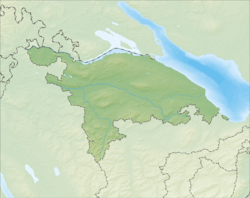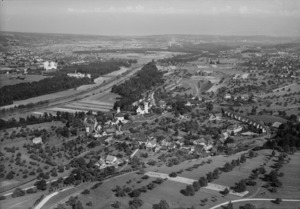Bussnang facts for kids
Quick facts for kids
Bussnang
|
||
|---|---|---|
 |
||
|
||
| Country | Switzerland | |
| Canton | Thurgau | |
| District | Weinfelden | |
| Area | ||
| • Total | 18.88 km2 (7.29 sq mi) | |
| Elevation | 445 m (1,460 ft) | |
| Population
(Dec 2020 )
|
||
| • Total | 2,473 | |
| • Density | 130.99/km2 (339.25/sq mi) | |
| Postal code |
9565
|
|
| Surrounded by | Affeltrangen, Amlikon-Bissegg, Braunau, Bürglen, Schönholzerswilen, Weinfelden | |
Bussnang is a small town, also called a municipality, in the Weinfelden area of the canton of Thurgau in Switzerland. It's a place with a long history and is known today for making trains!
Contents
Bussnang's Past: A Look at History
Bussnang was first mentioned way back in the year 822. It was called Pussinwanc then.
Early Times and Church History
In the Early Middle Ages (around 500-1000 AD), a big church called the Abbey of St. Gall owned a lot of land around Bussnang. Later, during the High Middle Ages (around 1000-1300 AD), a local noble family, the Baron of Bussnang, ruled the village.
The Gallus Church in Bussnang was started in 885. In 1123, it was given to Saint John the Baptist. For a long time, the Baron decided who would be the priest. But in 1464, this right went to a group called the Commandry of Tobel.
In 1529, the church changed to the Protestant faith because of a leader named Johannes Zwick. However, the traditional Catholic Mass was brought back in 1596. For many years, the village church was a shared church, meaning both Protestants and Catholics used it. This sharing continued until 1935 when the Catholic church built its own special round church.
Bridges and Economic Growth
A very old Roman bridge was built over the Thur River in 124 AD. Later, people used a ferry to cross the river until a new bridge was built in 1453. For a long time, Bussnang didn't grow much economically.
In 1882, the Ganggelisteg bridge was built just for people walking. This helped a little, but not much. A big railway bridge, called a viaduct, was built in 1912-13. This bridge carries the Mittel-Thurgau-Bahn rail line over the Furtbach valley.
Long ago, people in Bussnang mostly grew grain using a system where they rotated crops. They also had some vineyards. In the 1800s, farming changed. People started focusing more on raising cattle, producing dairy, and growing fruit. Some people also worked in weaving linen and cotton.
Since 1963, a very important company called Stadler Rail has been making electric trains in Bussnang. This company has brought a lot of jobs and growth to the area.
Bussnang's Location and Land
Bussnang covers an area of about 18.91 square kilometers (about 7.3 square miles). A large part of this land, about 70%, is used for farming. Forests cover about 19% of the area. The rest of the land is used for buildings, roads, rivers, or is unproductive.
The town is located about 2 kilometers (1.2 miles) southwest of the Weinfelden train station. The current municipality of Bussnang was formed in 1996. It brought together several smaller villages, or Ortsgemeinden, including Bussnang, Friltschen, Lanterswil, Mettlen, Oberbussnang, Oppikon, Reuti, and Rothenhausen.
People of Bussnang
Bussnang has a population of about 2,000 people. A small part of the population, about 7%, are people from other countries. Most people in Bussnang speak German. A few people also speak Turkish or Dutch.
Population Details
In 2008, there were slightly more men (50.4%) than women (49.6%) living in Bussnang. The population changes a bit each year due to births, deaths, and people moving in or out. In 2008, the population grew by about 2.3%.
Age Groups
The age groups in Bussnang are spread out:
- Children (0-9 years old): About 10.7%
- Teenagers (10-19 years old): About 15.2%
- Young Adults (20-29 years old): About 12.4%
- Adults (30-59 years old): About 42.8%
- Seniors (60+ years old): About 18.7%
Homes and Living
In 2000, there were about 708 homes in Bussnang, with an average of 2.8 people living in each home. Most of the buildings were single-family homes. Many people lived in homes with a partner and children.
The average rent for an apartment in Bussnang in 2000 was about 1080 Swiss francs (CHF) per month.
Voting and Politics
In the 2007 national election, the most popular political party in Bussnang was the SVP. About half of the people who could vote actually did vote in that election.
Historical Population
Here's how Bussnang's population has changed over the years:
| year | population |
|---|---|
| 1850 | 2,062 |
| 1900 | 2,058 |
| 1920 | 1,950 |
| 1950 | 2,220 |
| 1990 | 2,259 |
| 2000 | 2,085 |
Places to See
The small village, or hamlet, of Wertbühl in Bussnang is a special place. It is listed as part of the Inventory of Swiss Heritage Sites, which means it's important for its history and beauty.
Bussnang's Economy: Making Trains!
Bussnang's economy is greatly shaped by Stadler Rail. This company is one of the biggest train manufacturers in the world! Stadler Rail moved its main office to Bussnang in 1962.
At their Bussnang location, Stadler Rail not only sells trains but also designs and builds many types of electric trains. These include the SMILE, FLIRT, and GTW models. They also have a special division for custom-made trains, like those for mountain railways or trains that run on wider tracks.
Jobs in Bussnang
In 2007, the unemployment rate in Bussnang was very low, at 1.43%. This means most people who wanted to work had jobs.
In 2005, many people worked in different areas:
- Primary sector: About 232 people worked in farming and related businesses.
- Secondary sector: About 790 people worked in manufacturing, like making trains.
- Tertiary sector: About 271 people worked in services, like shops, schools, or offices.
Many people who live in Bussnang also work there. In 2000, about 46% of the people living in Bussnang worked outside the municipality, while 433 people came into Bussnang for work. Most people used a private car to get to work, but some used public transportation.
Religion in Bussnang
Based on the 2000 census, the people in Bussnang have different religious beliefs:
- About 30.8% were Roman Catholic.
- About 53.8% belonged to the Swiss Reformed Church (a Protestant church).
- A smaller number of people belonged to other Christian churches, the Islamic faith, or other religions.
- About 7.2% of the population said they didn't belong to any church or were agnostic or atheist.
Getting Around: Transport
Bussnang is located on the Wil–Kreuzlingen railway line. This line connects the towns of Wil and Weinfelden. Bussnang has its own train station, Bussnang station, and another nearby station called Oppikon. Both are served by the St. Gallen S-Bahn, which is like a local train system.
Learning in Bussnang: Education
Switzerland is known for its good education system. In Bussnang, about 77% of adults (aged 25-64) have finished either a non-mandatory upper secondary education or a higher education, like a university or a Fachhochschule (a type of professional university).
Bussnang has its own primary school district called Bussnang-Rothenhausen. In the 2008/2009 school year, there were 103 students. This included children in kindergarten and those in lower and upper primary levels. Class sizes were generally small, around 20-24 students.
Images for kids
See also
 In Spanish: Bussnang para niños
In Spanish: Bussnang para niños






